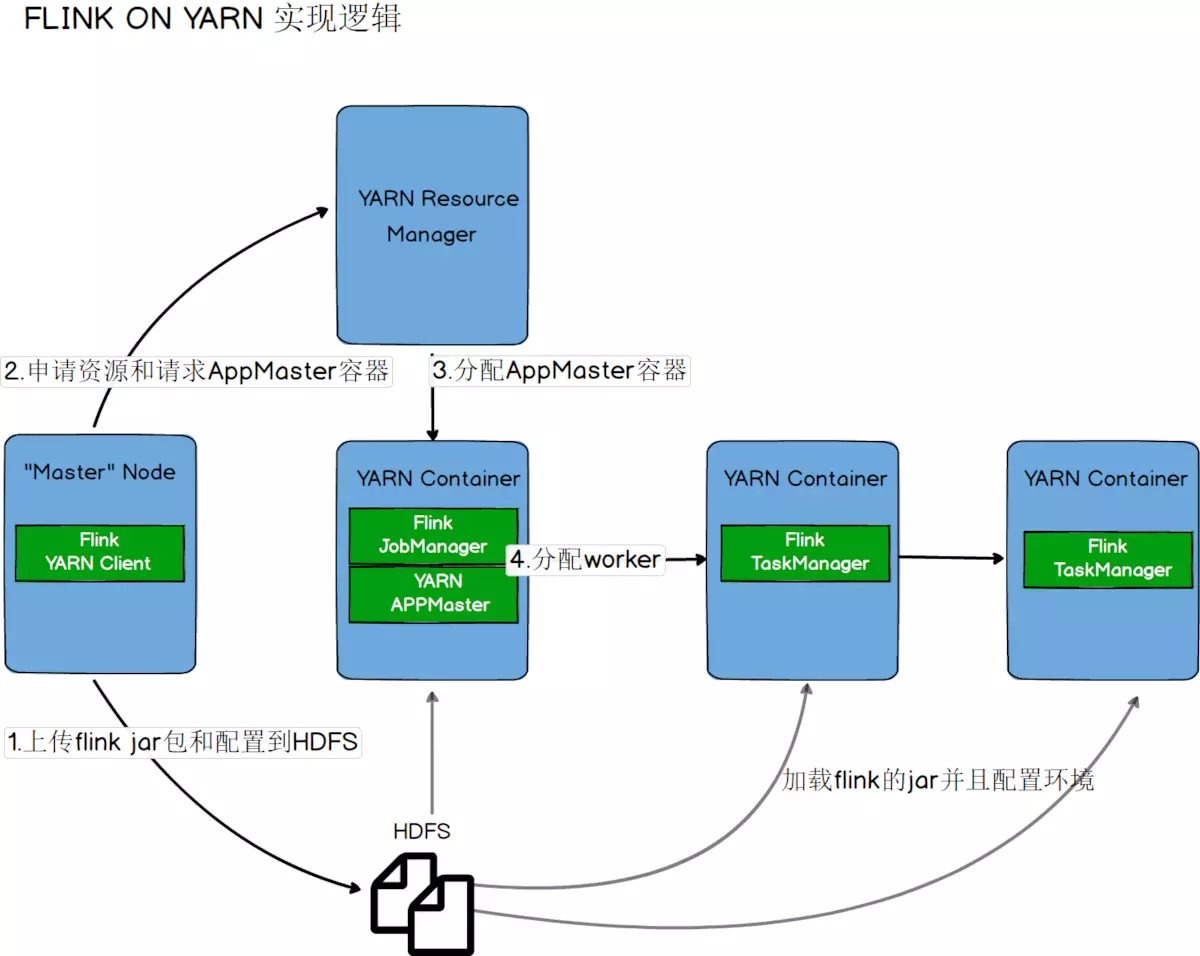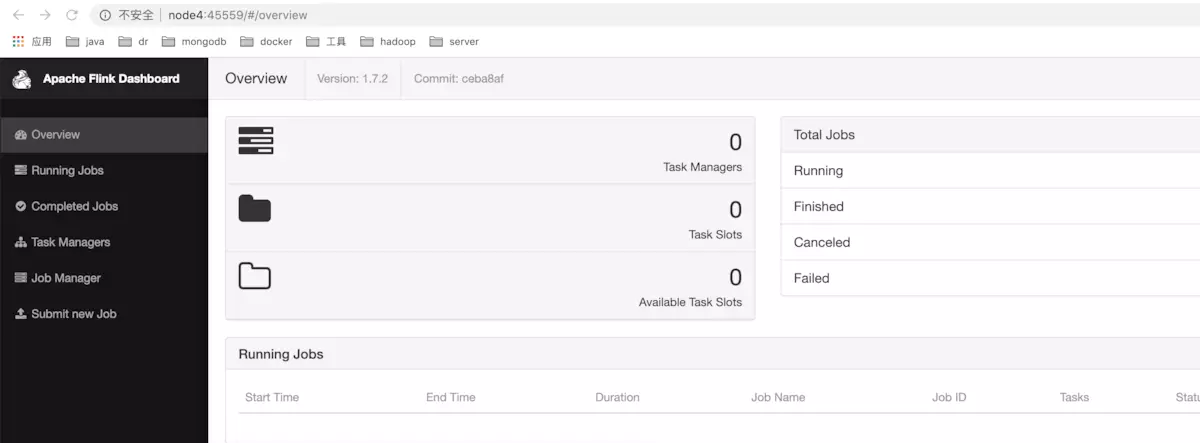三台主机 centos6
已经完成的工作:
- 防火墙已关闭
- 主机名修改完毕,ssh免密登陆配置完成
- jdk已安装
- zookeeper已经部署并运行
- hadoop已经部署并运行
版本:flink-1.8.2-bin-scala_2.11
上传或下载flink,解压缩
[root@node01 software]# tar -zxvf flink-1.8.2-bin-scala_2.11.tgz -C /bigdata/application/
配置环境变量,建立软连接
将官网hadoop的jar包放入lib目录下
编辑flink-conf.yaml
jobmanager.rpc.address:值设置成你master节点的IP地址
taskmanager.heap.mb:每个TaskManager可用的总内存
taskmanager.numberOfTaskSlots:每台机器上可用CPU的总数
parallelism.default:每个Job运行时默认的并行度
taskmanager.tmp.dirs:临时目录
jobmanager.heap.mb:每个节点的JVM能够分配的最大内存
jobmanager.rpc.port: 6123
jobmanager.web.port: 8081
################################################################################ # Licensed to the Apache Software Foundation (ASF) under one # or more contributor license agreements. See the NOTICE file # distributed with this work for additional information # regarding copyright ownership. The ASF licenses this file # to you under the Apache License, Version 2.0 (the # "License"); you may not use this file except in compliance # with the License. You may obtain a copy of the License at # # http://www.apache.org/licenses/LICENSE-2.0 # # Unless required by applicable law or agreed to in writing, software # distributed under the License is distributed on an "AS IS" BASIS, # WITHOUT WARRANTIES OR CONDITIONS OF ANY KIND, either express or implied. # See the License for the specific language governing permissions and # limitations under the License. ################################################################################ #============================================================================== # Common #============================================================================== # The external address of the host on which the JobManager runs and can be # reached by the TaskManagers and any clients which want to connect. This setting # is only used in Standalone mode and may be overwritten on the JobManager side # by specifying the --host <hostname> parameter of the bin/jobmanager.sh executable. # In high availability mode, if you use the bin/start-cluster.sh script and setup # the conf/masters file, this will be taken care of automatically. Yarn/Mesos # automatically configure the host name based on the hostname of the node where the # JobManager runs. jobmanager.rpc.address: node03 # The RPC port where the JobManager is reachable. jobmanager.rpc.port: 6123 # The heap size for the JobManager JVM jobmanager.heap.size: 1024m # The heap size for the TaskManager JVM taskmanager.heap.size: 1024m # The number of task slots that each TaskManager offers. Each slot runs one parallel pipeline. taskmanager.numberOfTaskSlots: 2 # The parallelism used for programs that did not specify and other parallelism. parallelism.default: 2 # The default file system scheme and authority. # # By default file paths without scheme are interpreted relative to the local # root file system 'file:///'. Use this to override the default and interpret # relative paths relative to a different file system, # for example 'hdfs://mynamenode:12345' # fs.default-scheme: hdfs://ns/ #============================================================================== # High Availability #============================================================================== # The high-availability mode. Possible options are 'NONE' or 'zookeeper'. # high-availability: zookeeper # The path where metadata for master recovery is persisted. While ZooKeeper stores # the small ground truth for checkpoint and leader election, this location stores # the larger objects, like persisted dataflow graphs. # # Must be a durable file system that is accessible from all nodes # (like HDFS, S3, Ceph, nfs, ...) # high-availability.storageDir: hdfs://ns/flink/ha/ # The list of ZooKeeper quorum peers that coordinate the high-availability # setup. This must be a list of the form: # "host1:clientPort,host2:clientPort,..." (default clientPort: 2181) # high-availability.zookeeper.quorum: node01:2181,node02:2181,node03:2181 high-availability.zookeeper.path.root: /flink # ACL options are based on https://zookeeper.apache.org/doc/r3.1.2/zookeeperProgrammers.html#sc_BuiltinACLSchemes # It can be either "creator" (ZOO_CREATE_ALL_ACL) or "open" (ZOO_OPEN_ACL_UNSAFE) # The default value is "open" and it can be changed to "creator" if ZK security is enabled # # high-availability.zookeeper.client.acl: open #============================================================================== # Fault tolerance and checkpointing #============================================================================== # The backend that will be used to store operator state checkpoints if # checkpointing is enabled. # # Supported backends are 'jobmanager', 'filesystem', 'rocksdb', or the # <class-name-of-factory>. # state.backend: filesystem # Directory for checkpoints filesystem, when using any of the default bundled # state backends. # state.checkpoints.dir: hdfs://ns/flink-checkpoints # Default target directory for savepoints, optional. # state.savepoints.dir: hdfs://ns/flink-checkpoints # Flag to enable/disable incremental checkpoints for backends that # support incremental checkpoints (like the RocksDB state backend). # # state.backend.incremental: false #============================================================================== # Rest & web frontend #============================================================================== # The port to which the REST client connects to. If rest.bind-port has # not been specified, then the server will bind to this port as well. # rest.port: 8081 # The address to which the REST client will connect to # #rest.address: 0.0.0.0 # Port range for the REST and web server to bind to. # #rest.bind-port: 8080-8090 # The address that the REST & web server binds to # #rest.bind-address: 0.0.0.0 # Flag to specify whether job submission is enabled from the web-based # runtime monitor. Uncomment to disable. web.submit.enable: true #============================================================================== # Advanced #============================================================================== # Override the directories for temporary files. If not specified, the # system-specific Java temporary directory (java.io.tmpdir property) is taken. # # For framework setups on Yarn or Mesos, Flink will automatically pick up the # containers' temp directories without any need for configuration. # # Add a delimited list for multiple directories, using the system directory # delimiter (colon ':' on unix) or a comma, e.g.: # /data1/tmp:/data2/tmp:/data3/tmp # # Note: Each directory entry is read from and written to by a different I/O # thread. You can include the same directory multiple times in order to create # multiple I/O threads against that directory. This is for example relevant for # high-throughput RAIDs. # # io.tmp.dirs: /tmp # Specify whether TaskManager's managed memory should be allocated when starting # up (true) or when memory is requested. # # We recommend to set this value to 'true' only in setups for pure batch # processing (DataSet API). Streaming setups currently do not use the TaskManager's # managed memory: The 'rocksdb' state backend uses RocksDB's own memory management, # while the 'memory' and 'filesystem' backends explicitly keep data as objects # to save on serialization cost. # # taskmanager.memory.preallocate: false # The classloading resolve order. Possible values are 'child-first' (Flink's default) # and 'parent-first' (Java's default). # # Child first classloading allows users to use different dependency/library # versions in their application than those in the classpath. Switching back # to 'parent-first' may help with debugging dependency issues. # # classloader.resolve-order: child-first # The amount of memory going to the network stack. These numbers usually need # no tuning. Adjusting them may be necessary in case of an "Insufficient number # of network buffers" error. The default min is 64MB, the default max is 1GB. # # taskmanager.network.memory.fraction: 0.1 # taskmanager.network.memory.min: 64mb # taskmanager.network.memory.max: 1gb #============================================================================== # Flink Cluster Security Configuration #============================================================================== # Kerberos authentication for various components - Hadoop, ZooKeeper, and connectors - # may be enabled in four steps: # 1. configure the local krb5.conf file # 2. provide Kerberos credentials (either a keytab or a ticket cache w/ kinit) # 3. make the credentials available to various JAAS login contexts # 4. configure the connector to use JAAS/SASL # The below configure how Kerberos credentials are provided. A keytab will be used instead of # a ticket cache if the keytab path and principal are set. # security.kerberos.login.use-ticket-cache: true # security.kerberos.login.keytab: /path/to/kerberos/keytab # security.kerberos.login.principal: flink-user # The configuration below defines which JAAS login contexts # security.kerberos.login.contexts: Client,KafkaClient #============================================================================== # ZK Security Configuration #============================================================================== # Below configurations are applicable if ZK ensemble is configured for security # Override below configuration to provide custom ZK service name if configured # zookeeper.sasl.service-name: zookeeper # The configuration below must match one of the values set in "security.kerberos.login.contexts" # zookeeper.sasl.login-context-name: Client #============================================================================== # HistoryServer #============================================================================== # The HistoryServer is started and stopped via bin/historyserver.sh (start|stop) # Directory to upload completed jobs to. Add this directory to the list of # monitored directories of the HistoryServer as well (see below). #jobmanager.archive.fs.dir: hdfs:///completed-jobs/ # The address under which the web-based HistoryServer listens. #historyserver.web.address: 0.0.0.0 # The port under which the web-based HistoryServer listens. historyserver.web.port: 8082 # Comma separated list of directories to monitor for completed jobs. #historyserver.archive.fs.dir: hdfs:///completed-jobs/ # Interval in milliseconds for refreshing the monitored directories. #historyserver.archive.fs.refresh-interval: 10000 yarn.application-attempts: 10
编辑master文件
node03:8086 node01:8086
编辑slaves文件
node01
node02
node03
编辑zoo.cfg文件
################################################################################ # Licensed to the Apache Software Foundation (ASF) under one # or more contributor license agreements. See the NOTICE file # distributed with this work for additional information # regarding copyright ownership. The ASF licenses this file # to you under the Apache License, Version 2.0 (the # "License"); you may not use this file except in compliance # with the License. You may obtain a copy of the License at # # http://www.apache.org/licenses/LICENSE-2.0 # # Unless required by applicable law or agreed to in writing, software # distributed under the License is distributed on an "AS IS" BASIS, # WITHOUT WARRANTIES OR CONDITIONS OF ANY KIND, either express or implied. # See the License for the specific language governing permissions and # limitations under the License. ################################################################################ # The number of milliseconds of each tick tickTime=2000 # The number of ticks that the initial synchronization phase can take initLimit=10 # The number of ticks that can pass between sending a request and getting an acknowledgement syncLimit=5 # The directory where the snapshot is stored. # dataDir=/tmp/zookeeper # The port at which the clients will connect clientPort=2181 # ZooKeeper quorum peers server.1=node01:2888:3888 server.2=node02:2888:3888 server.3=node03:2888:3888 # server.2=host:peer-port:leader-port
复制到各个节点,配置环境变量,软连接
启动
bin下通过start-cluster.sh启动
访问node03:8086
Flink On Yarn模式
 flink on yarn
flink on yarn1.第一种方式:yarn-session.sh(开辟资源)+flink run(提交任务)
启动一个一直运行的flink集群
# 下面的命令会申请5个taskmanager,每个2G内存和2个solt,超过集群总资源将会启动失败。 ./bin/yarn-session.sh -n 5 -tm 2048 -s 2 --nm leo-flink -d-n ,--container <arg> 分配多少个yarn容器(=taskmanager的数量)
-D <arg> 动态属性
-d, --detached 独立运行
-jm,--jobManagerMemory <arg> JobManager的内存 [in MB]
-nm,--name 在YARN上为一个自定义的应用设置一个名字
-q,--query 显示yarn中可用的资源 (内存, cpu核数)
-qu,--queue <arg> 指定YARN队列.
-s,--slots <arg> 每个TaskManager使用的slots(vcore)数量
-tm,--taskManagerMemory <arg> 每个TaskManager的内存 [in MB]
-z,--zookeeperNamespace <arg> 针对HA模式在zookeeper上创建NameSpace
请注意:
请注意:client必须要设置YARN_CONF_DIR或者HADOOP_CONF_DIR环境变量,通过这个环境变量来读取YARN和HDFS的配置信息,否则启动会失败。
经实验发现,其实如果配置的有HADOOP_HOME环境变量的话也是可以的(只是会出现警告)。HADOOP_HOME ,YARN_CONF_DIR,HADOOP_CONF_DIR 只要配置的有任何一个即可。运行结果如图:
 yarn-flink
yarn-flink浏览器中访问 http://node4:45559
 yarn-flink
yarn-flinkyarn web-ui中
 yarn-flink
yarn-flink
部署长期运行的flink on yarn实例后,在flink web上看到的TaskManager以及Slots都为0。只有在提交任务的时候,才会依据分配资源给对应的任务执行。</p>提交Job到长期运行的flink on yarn实例上:
./bin/flink run ./examples/batch/WordCount.jar -input hdfs://leo/test/test.txt -output hdfs://leo/flink-word-count通过web ui可以看到已经运行完成的任务:
task2.第二种方式:flink run -m yarn-cluster(开辟资源+提交任务)
./bin/flink run -m yarn-cluster -yn 2 -yjm 1024 -ytm 1024 ./examples/batch/WordCount.jar -input hdfs://leo/test/test.txt -output hdfs://leo/test/flink-word-count2.txtyarn web ui上查看刚刚提交的任务已经执行成功
 task
task作者:NikolasNull
链接:https://www.jianshu.com/p/4dc0a980e7e9
来源:简书
著作权归作者所有。商业转载请联系作者获得授权,非商业转载请注明出处。
[root@node03 bin]# start-cluster.sh Starting HA cluster with 2 masters. ssh: connect to host node03 port 22: No buffer space available Starting standalonesession daemon on host node01. Starting taskexecutor daemon on host node01. Starting taskexecutor daemon on host node02. ssh: connect to host node03 port 22: No buffer space available [root@node03 bin]# start-cluster.sh Starting HA cluster with 2 masters. ssh: connect to host node03 port 22: No buffer space available [INFO] 1 instance(s) of standalonesession are already running on node01. Starting standalonesession daemon on host node01. [INFO] 1 instance(s) of taskexecutor are already running on node01. Starting taskexecutor daemon on host node01. [INFO] 1 instance(s) of taskexecutor are already running on node02. Starting taskexecutor daemon on host node02. ssh: connect to host node03 port 22: No buffer space available [root@node03 bin]# echo 512 > /proc/sys/net/ipv4/neigh/default/gc_thresh1 [root@node03 bin]# echo 2048 > /proc/sys/net/ipv4/neigh/default/gc_thresh2 [root@node03 bin]# echo 4096 > /proc/sys/net/ipv4/neigh/default/gc_thresh3
ping 或者ssh 发生connect: No buffer space available 错误
如果遇到这种情况,一般说明你的本地服务器的arp表缓存太大,而服务器内核设定的回收条数太小,一直被回收造成的。
可以用一下命令扩大arp表可以缓存的记录条数:
echo 512 > /proc/sys/net/ipv4/neigh/default/gc_thresh1 echo 2048 > /proc/sys/net/ipv4/neigh/default/gc_thresh2 echo 4096 > /proc/sys/net/ipv4/neigh/default/gc_thresh3这三个值缺省是128,512,1024,我用arp -an |wc -l 看到自己服务器的arp缓存表竟然有300多条记录,修改完成后马上就好了,最后记得把
这三条写入/etc/rc.local 文件中,每次重启都写入下,不然机器重启就又被还原至缺省值了。
